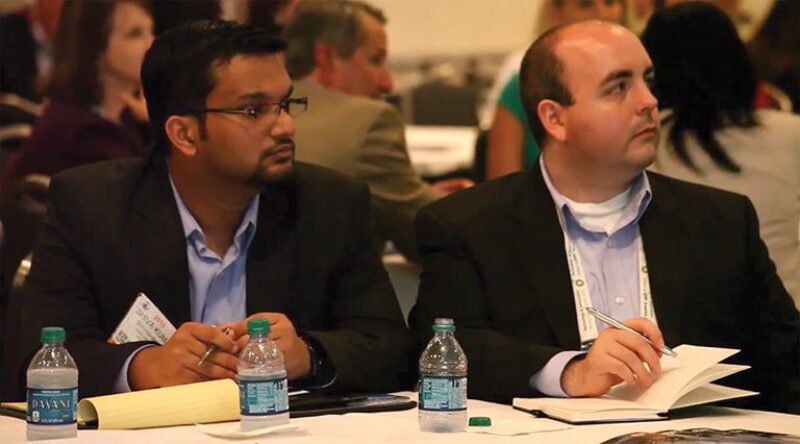Oil and Gas Facilities sponsored a networking event at the Offshore Technology Conference in Houston, Texas, in May to spark discussion about improving the success rates of major projects by ensuring the technical competence of engineers. Approximately 190 participants joined a panel of speakers in generating ideas during the “Assuring Technical Competence in Major Infrastructure Projects” session.
A panel moderated by Ken Arnold, senior technical adviser at Worley-Parsons, included Louis Bon, vice president of exploration and production (E&P) operations at Total; Murray Burns, recently retired senior vice president of topsides and fixed platforms at Technip; Richard Westney, founder and director of Westney Consulting Group; and Per Aae Staunstrup, head of engineering at Maersk Oil for the Chissonga development.
Arnold began the discussion by citing research done by Merrow (2012) that found the performance of E&P megaprojects—measured by overspending, schedule slippage, and continuing production problems in the first 2 years—stands at a failure rate of 75%. Twenty years ago, the failure rate was 50% and comparable to other industries. Though not stellar, the 50% failure rate for E&P projects further increased by 25%, while other industries’ failure rates held steady over 20 years.
Arnold said that in the past, major oil and gas companies had training programs for a class of in-house engineers called facilities or infrastructure engineers. These engineers received extensive formal training by experienced subject matter experts. In their early careers, experience was gained through temporary assignments in various engineering groups to better understand the validity and uncertainties in data, and in operating groups to learn the practical aspects of how the engineers’ designs affected real-world operational problems. They learned the technology of facilities engineering by working on small-scale projects under the tutelage of mentors who were knowledgeable in the technology of facilities engineering, and they learned the technology of project management by working as team members of larger projects. Many of these engineers eventually migrated to engineering companies and formed the basis of the companies’ technology backbones.
Over time, however, oil companies no longer considered facilities engineering to be a “core competency.” The companies instead relied on engineering firms, or nonemployee contractors, for the expertise needed for conceptual studies and detail design of major facilities projects.
The continuity and comprehensiveness of training was lost. Engineering companies developed policies, and procedure and quality control checks through means such as hazards analysis, standardized sizing procedures, and risk management studies. Oil companies defined detailed stage gate processes to assure the quality of the work provided by the engineering companies.
Arnold said that engineers today do not have opportunities to work with other disciplines. Trips to offshore facilities or visits to fabrication yards are no longer the norm. Instead, the industry focuses on minimizing nonbillable hours and views engineering as a profession that does not require thought processes.

Westney identified two challenges to developing project competencies: mentoring and the ability to apply knowledge. Tacit and explicit knowledge are critical in changing the nature of projects. Tacit knowledge is a deep understanding of something usually gained through experience within a certain context and is not easily transferred from one person to another. Explicit knowledge, however, is acquired through formal training. Westney said competency is a function of tacit and explicit knowledge and knowing how to use it. Without explicit knowledge, tacit knowledge can be useless.
Bon asked, “How do we take an engineer just out of school with a head full of equations and formulas and make him or her a project manager?” To develop competency, Total trains facilities engineers through two years in each of the following: process engineering, field operations, and projects. After six years of experience, the engineers decide on their preferred area. Bon said the training makes better project engineers because they have gained experience in all areas.
Burns pointed to onerous contract conditions between operators and engineering companies as an obstacle to providing training to young professionals. Unlike in earlier times, operators today do not show the same willingness to allow engineering companies to be involved in all steps of a project, limiting the hands-on experience for nonemployee facilities engineers.
Managers are focused on delivering tangible results, such as meeting schedule and cost goals, Staunstrup said. They should also consider the importance of developing engineers to “grow out of their position,” he said. He highlighted the gap that exists between actual training for competency and the needs for competency identified in project planning. The presumption seems to be that “someone else will provide the competencies.” Engineering companies look to the major oil and gas companies, while the oil and gas companies look to the engineering companies for the needed competencies.
The breakout session following the panelists’ comments was structured to address five topics. The topics and participants’ recommendations follow:
- Mentoring models: Both employee and company are responsible for mentoring; it must be viewed as a two-way street. Proposed a portfolio mentorship model in which each mentee has a portfolio of mentors.
- Effective means of acquiring explicit knowledge: Information sharing, such as lessons learned and internal wikis. Proposed that each person is allowed to learn through the means that works best for him or her.
- Effective means of acquiring tacit knowledge: Ability to work with mentors who are noncompetitive. Operators should dedicate a budget for new employee development.
- Improvement of competencies, motivation, and behavioral norms: Proposed implementation of a project management office in companies. Give staff more authority at earlier stages and allow junior engineers to make decisions.
- Development of long-term plans to assure access to competent people: Operators should make commercial allowance for training of contractor personnel within project budgets. Operators should refrain from poaching talent from engineering companies. Engineering contractors should provide career paths to retain talent. Operators should promote a culture of long-term relationships with contractors.
For Further Reading
Merrow, E.W. 2012. Oil and Gas Industry Megaprojects: Our Recent Track Record, Oil and Gas Fac. 1(2): 38–42.

